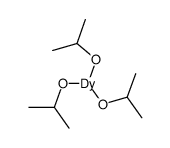6742-68-3
| Name | dysprosium(3+),propan-2-olate |
|---|---|
| Synonyms |
dysprosium tripropan-2-olate
Dysprosiumtriisopropoxide |
| Molecular Formula | C9H21DyO3 |
|---|---|
| Molecular Weight | 339.76100 |
| Exact Mass | 341.07800 |
| PSA | 27.69000 |
| LogP | 2.62710 |
|
Section 1: Product Identification Chemical Name:Dysprosium (III) i-propoxide (99.9%-Dy) (REO) CAS Registry Number:6742-68-3 Formula:Dy(OC3H7)3 EINECS Number: Chemical Family:metal alkoxide Synonym:dysprosium isopropanolate, isopropanol, dysprosium salt.
Section 2: Composition and Information on Ingredients IngredientCAS NumberPercentACGIH (TWA)OSHA (PEL) Title Compound6742-68-3100%no datano data Section 3: Hazards Identification The product is moderately caustic. Dust is irritating to eyes, skin and respiratory tract. Moisture will produce Emergency Overview: isopropanol vapor which may cause drowsiness. Primary Routes of Exposure:Inhalation, ingestion, contact with skin and eyes. Eye Contact:The dust and the isopropanol released on hydrolysis causes moderate to severe irritation of the eyes. Skin Contact:Forms mildly alkaline oxide powder that irritates the skin. Dust causes moderate irritation to the upper respiratory tract. isopropanol vapor may cause dizziness and Inhalation: drowsiness Ingestion:Ingestion may cause moderate irritation of the gastrointestinal tract, nausea, vomiting, headache, and coma. The product is alkaline and a moderate irritant. isopropanol is a skin and eye irritant. Exposure may cause Acute Health Affects: impairment of coordination and reaction time. No data is available for this product. Isopropanol is a possible mutagen, tumorigen and reproductive effector. Chronic Health Affects: Prolonged exposure may damage nerves, kidneys, and the cardiovascular system. NTP:No IARC:No OSHA:No SECTION 4: First Aid Measures Immediately flush the eyes with copious amounts of water for at least 10-15 minutes. A victim may need Eye Exposure: assistance in keeping their eye lids open. Get immediate medical attention. Wash the affected area with soap and water. Remove contaminated clothes if necessary. Seek medical Skin Exposure: assistance if irritation persists. Remove the victim to fresh air. Closely monitor the victim for signs of respiratory problems, such as difficulty Inhalation: in breathing, coughing, wheezing, or pain. In such cases seek immediate medical assistance. Ingestion:Seek medical attention immediately. Keep the victim calm. Give the victim water (only if conscious). SECTION 5: Fire Fighting Measures Flash Point:not applicable Autoignition Temperature:no data Explosion Limits:no data Extinguishing Medium:carbon dioxide, dry powder or foam If involved in a fire, fire fighters should be equipped with a NIOSH approved positive pressure self-contained Special Fire Fighting Procedures: breathing apparatus and full protective clothing. Hazardous Combustion andIf involved in a fire this material may emit toxic organic fumes. Decomposion Products: Unusual Fire or Explosion Hazards: Highly flammable. Formation of explosive air/dust mixtures is possible in presence of moisture. SECTION 6: Accidental Release Measures Eliminate all ignition sources. Avoid contact with water. Small spills may be adsorbed into diatomaceous earth, Spill and Leak Procedures: sand, or other suitable adsorbent, and swept up. SECTION 7: Handling and Storage Store in a tightly sealed container in a dry place. If container is left open, product may adsorb moisture and Handling and Storage: carbon dioxide from the atmosphere and release isopropanol vapor. SECTION 8: Exposure Controls and Personal Protection Eye Protection:Always wear approved safety glasses when handling a chemical substance in the laboratory. Skin Protection:Wear protective clothing and gloves. Ventilation:Material may form a vapor upon exposure to air. if possible, handle the material in an efficient fume hood. If ventilation is not available a respirator should be worn. The use of respirators requires a Respirator Respirator: Protection Program to be in compliance with 29 CFR 1910.134. Ventilation:Material may form a vapor upon exposure to air. if possible, handle the material in an efficient fume hood. Additional Protection:No additional protection required. SECTION 9: Physical and Chemical Properties Color and Form:tan pwdr. Molecular Weight:339.77 Melting Point:no data Boiling Point:no data Vapor Pressure:no data Specific Gravity:no data Odor:alcohol-like odor Solubility in Water:reacts with water SECTION 10: Stability and Reactivity Stability:air and moisture sensitive solid Hazardous Polymerization:no hazardous polymerization Conditions to Avoid:Keep away from moisture, heat and ignition sources including open flame and electrostatic discharge. Incompatibility:water, mineral acids and halogens Decomposition Products:Carbon dioxide, carbon monoxide, organic vapors, and metal oxides and carbonates. SECTION 11: Toxicological Information RTECS Data:No specific information available on this product. Carcinogenic Effects:No data available Mutagenic Effects:No data available Tetratogenic Effects:No data available SECTION 12: Ecological Information Ecological Information:No information available SECTION 13: Disposal Considerations Disposal:Dispose of according to local, state and federal regulations. SECTION 14: Transportation Shipping Name (CFR):Flammable solids, Organic, N.O.S. Hazard Class (CFR):4.1 Additional Hazard Class (CFR):NA Packaging Group (CFR):II UN ID Number (CFR):UN# 1325 Shipping Name (IATA):Flammable solid, Organic, N.O.S. Hazard Class (IATA):4.1 Additional Hazard Class (IATA):NA Packaging Group (IATA):II UN ID Number (IATA):UN# 1325 SECTION 15: Regulatory Information TSCA:Not listed in the TSCA inventory. SARA (Title 313):Title compound not listed. Second Ingredient:none SECTION 16 - ADDITIONAL INFORMATION N/A |
| Risk Phrases | 36/37/38 |
|---|---|
| Safety Phrases | S26-S36-S37-S39 |
| RIDADR | UN3274 |
| Packaging Group | II |
